
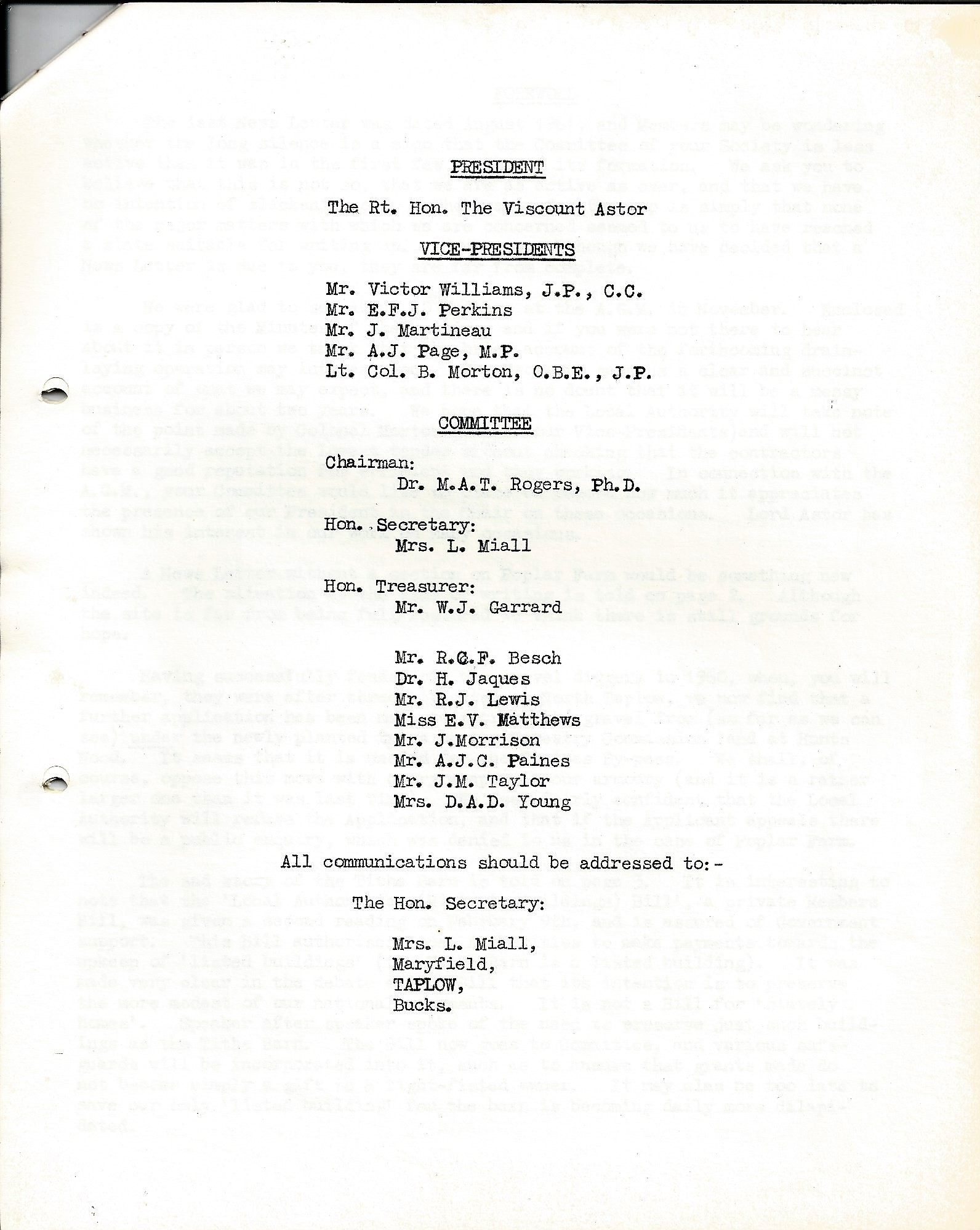
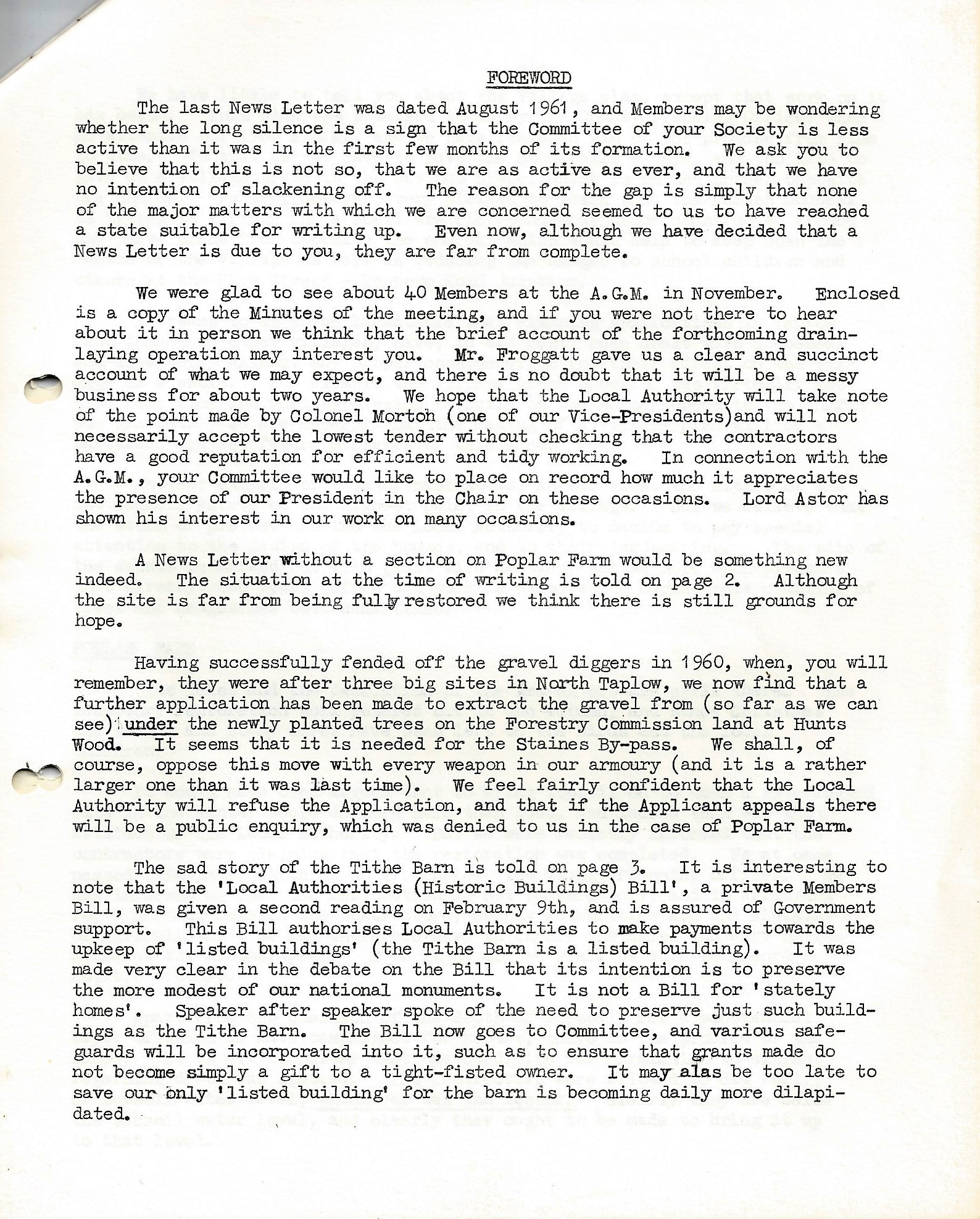
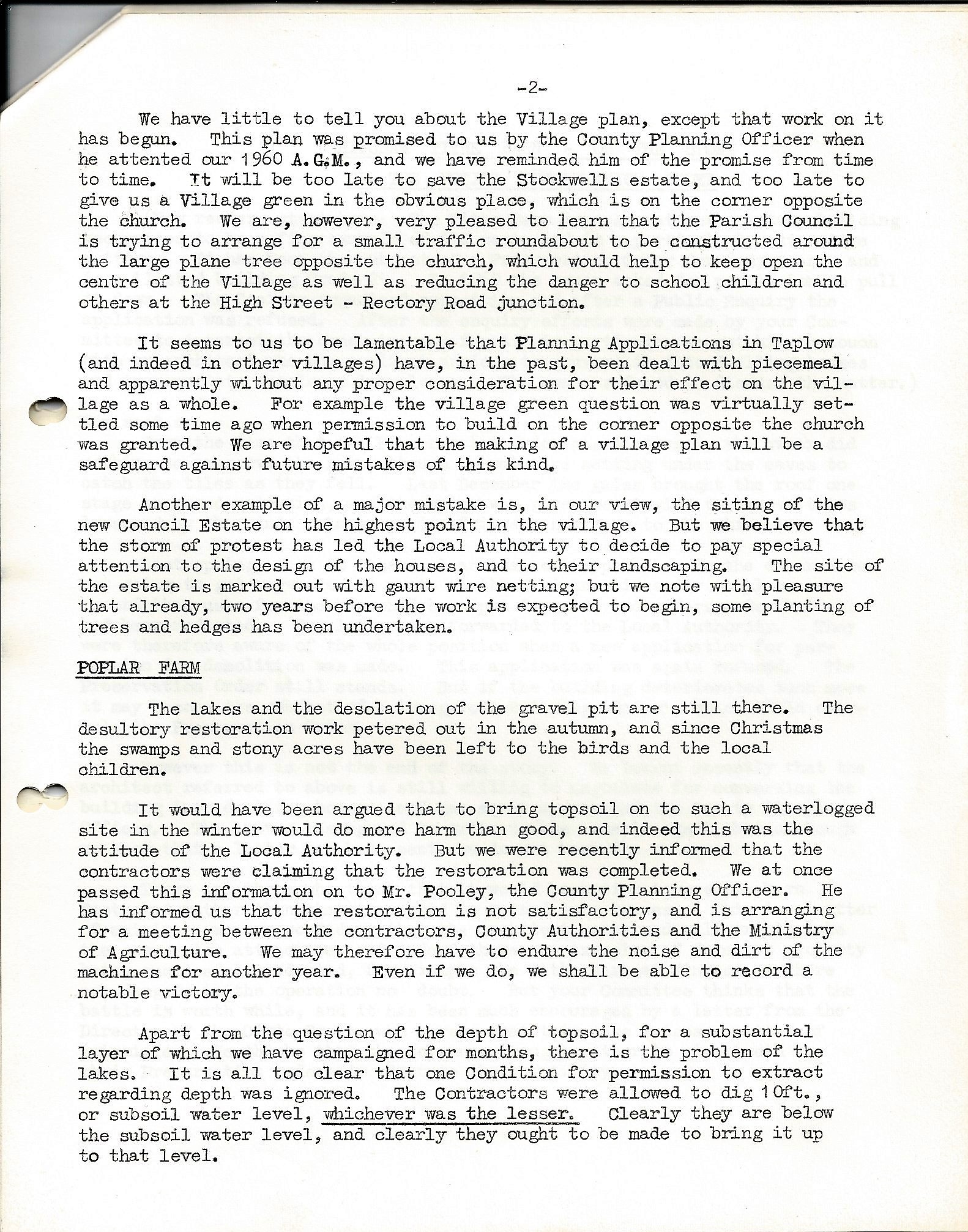
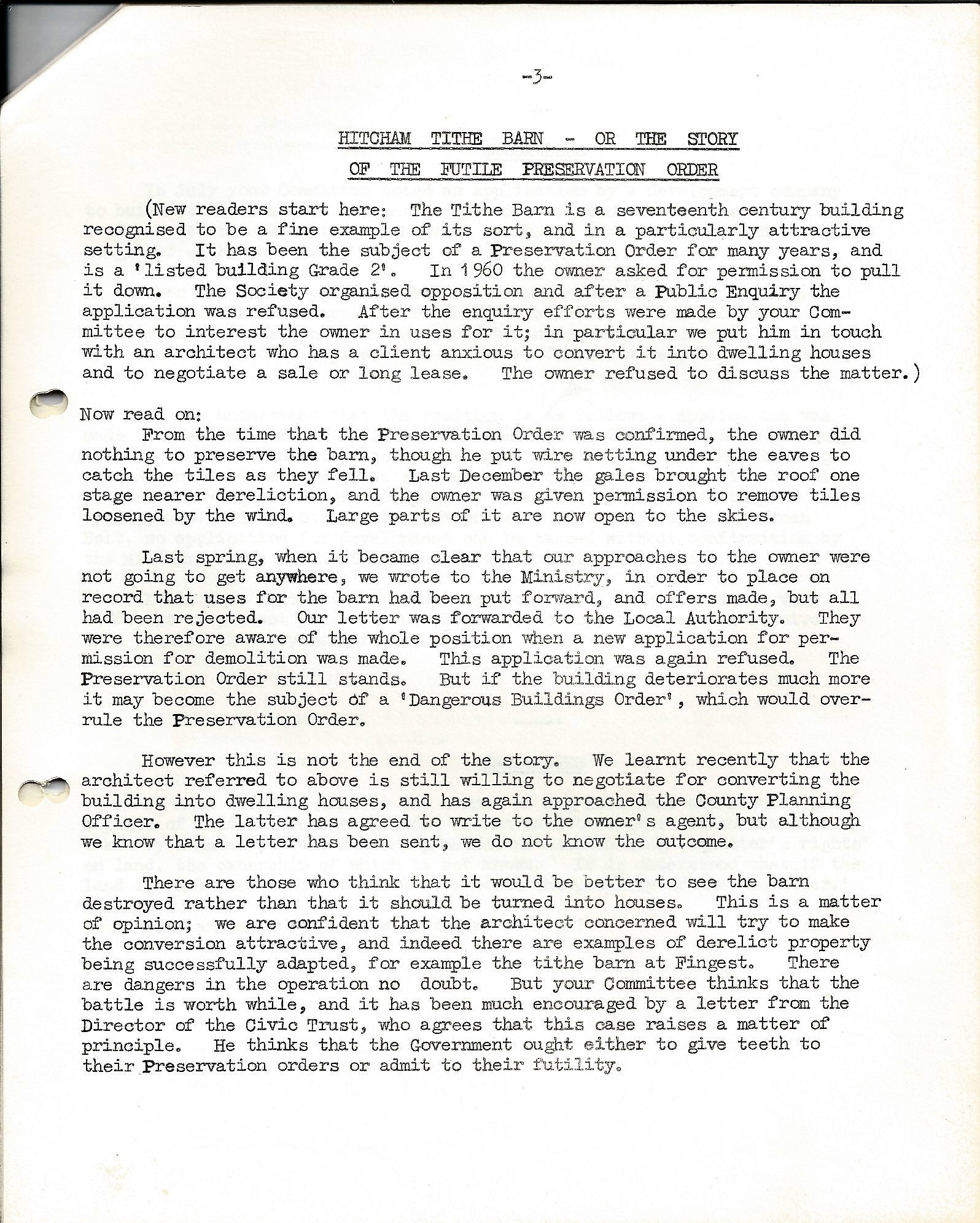
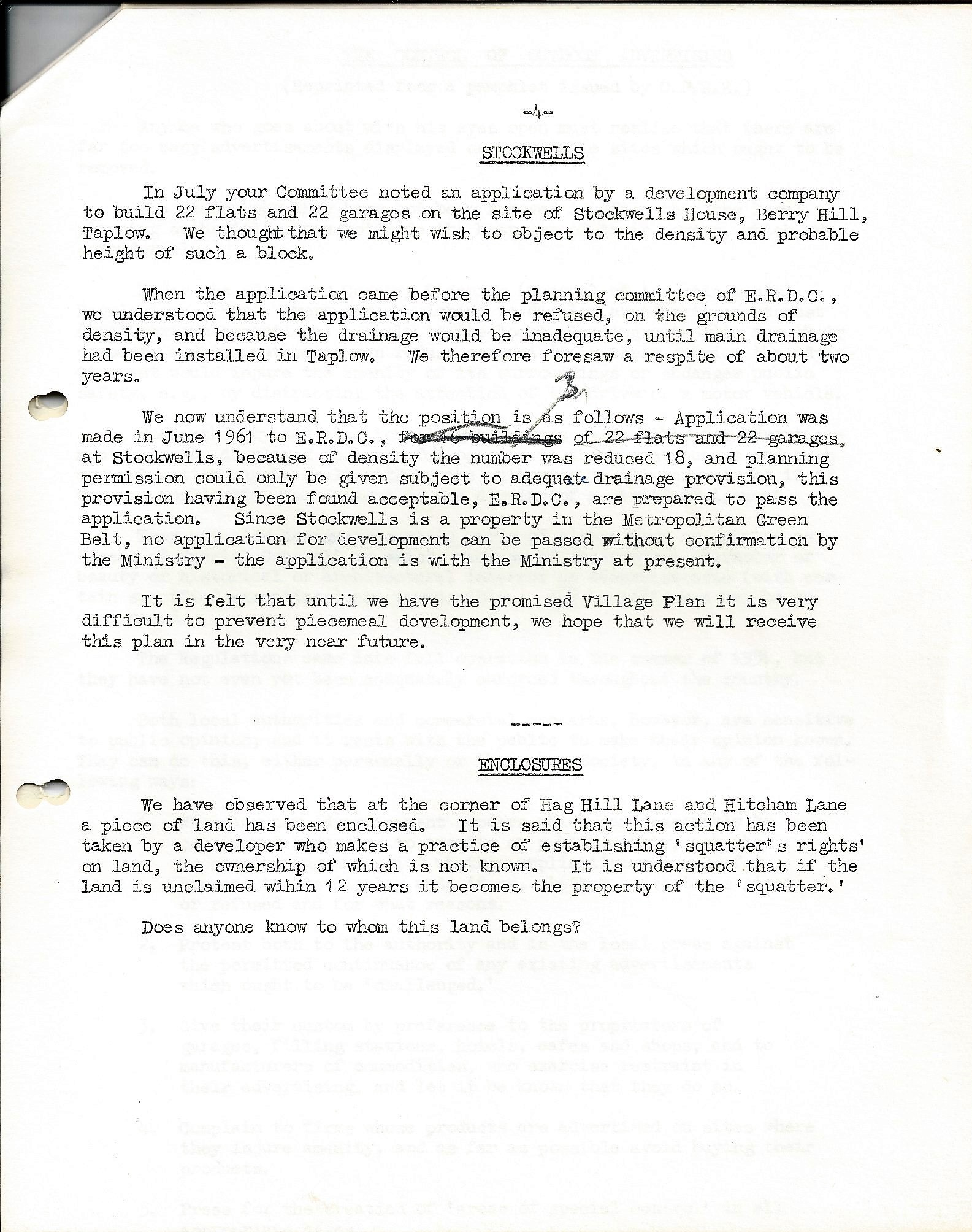
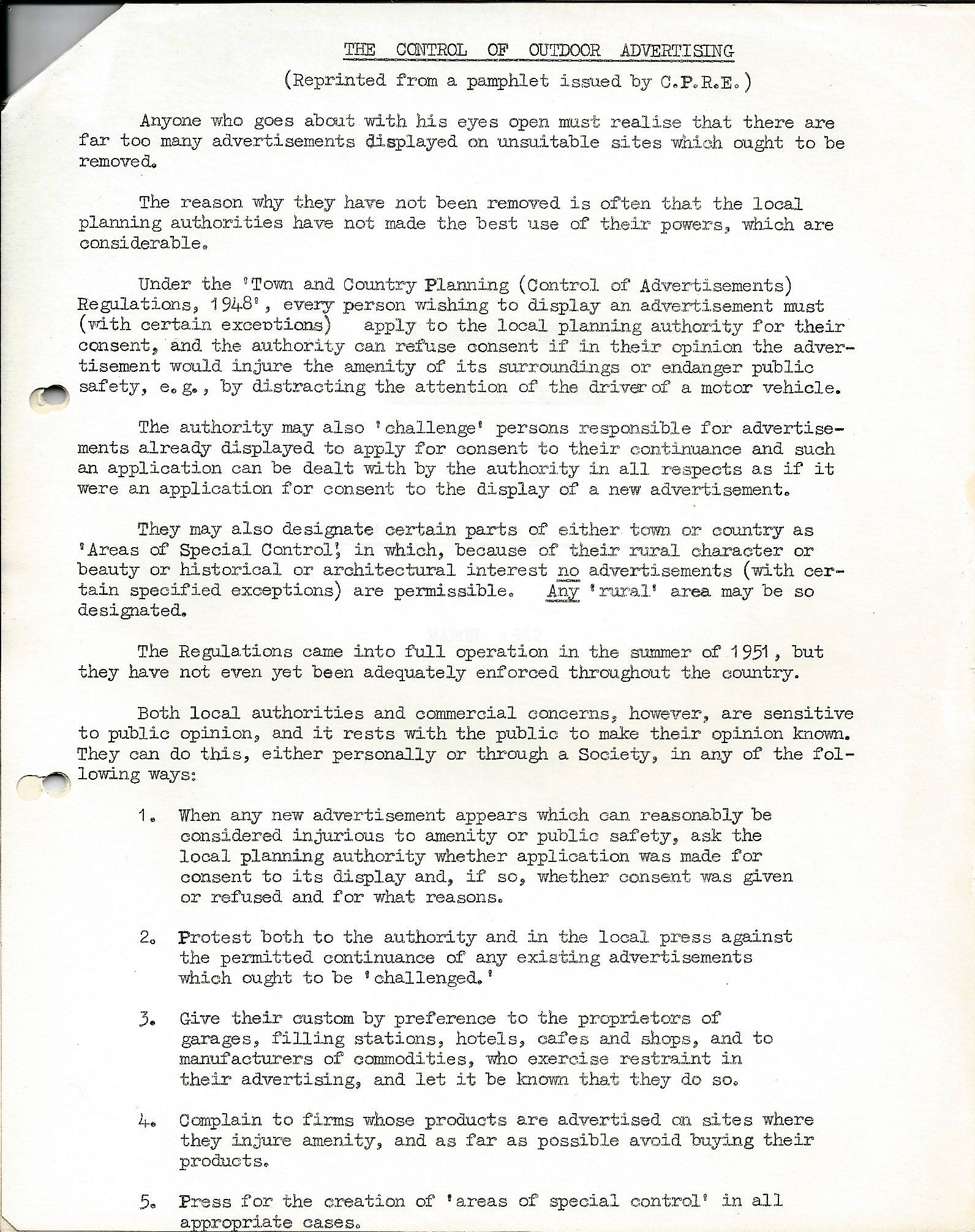
HITCHAM AND TAPLOW
PRESERVATION SOCIETY
NEWS LETTER No.6
MARCH 1962
PRESIDENT
The Rt. Hon. The Viscount Astor
VICE-PRESIDENTS
Mr. Victor Williams, J.P., C.C.
Mr. E.F.J. Perkins
Mr. J. Martineau
Mr. A.J. Page, M.P.
Lt. Col. B. Morton, 0.B.E., J.P.
COMMITTEE
Chairman:
Dr. M.A.T. Rogers, Ph.D.
Hon. Secretary:
Mrs. L. Miall
Hon. Treasurer:
Mr. W.J. Garrard
Mr. R. C. F. Besch
Dr. H. Jaques
Mr. R.J. Lewis
Miss E.V. Matthews
Mr. J.Morrison
Mr. A.J.C. Paines
Mr. J.M. Taylor
Mrs. D.A.D. Young
All communications should be addressed to:—
The Hon. Secretary:
Mrs L. Miall,
Maryfield,
TAPLOW,
Bucks.
FOREWORD
The last News Letter was dated August 1961, and Members may be wondering whether the long silence is a sign that the Committee of your Society is less active than it was in the first few months of its formation. We ask you to believe that this is not so, that we are as active as ever, and that We have no intention of slackening off. The reason for the gap is simply that none of the major matters with which we are concerned seemed to us to have reached a state suitable for writing up. Even now, although we have decided that a News Letter is due to you, they are far from complete.
We were glad to see about 1.0 Members at the A.G.M. in November. Enclosed is a copy of the Minutes of the meeting, and if you were not there to hear about it in person we think that the brief account of the forthcoming drain— laying operation may interest you. Mr. Froggatt gave us a clear and succinct account of what we may expect, and there is no doubt that it will be a messy business for about two years. We hope that the Local Authority will take note of the point made by Colonel Morton (one of our Vice—Presidents) and will not necessarily accept the lowast tender without checking that the contractors have a good reputation for efficient and tidy working. In connection with the A.G.M. , your Committee would like to place on record how much it appreciates the presence of our President in the Chair on these occasions. Lord Astor has shown his interest in our work on many occasions.
A News Letter without a section on Poplar Farm would be something new indeed. The situation at the time of writing is told on page 2. Although the site is far from being fuly restored we think there is still grounds for hope.
Having successfully fended off the gravel diggers in 1960, when, you will remember, they were after three big sites in North Taplow, we now find that a further application has been made to extract the gravel from (so far as we can see)’l under the nery planted trees on the Forestry Commission land at Hunts Wood. It seems that it is needed for the Staines By-pass. We shall, of course, oppose this move with every weapon in our armcury (and it is a rather larger one than it was last time). We feel fairly confident that the Local Authority will refuse the Application, and that if the Applicant appeals there will be a public enquiry, which was denied to us in the case of Poplar Farm.
The sad story of the Tithe Barn is told on page 3. It is interesting to note that the ‘Local Authorities (Historic Buildings) Bill’ , a private Members Bill, was given a second reading on February 9th, and is assured of Government support. This Bill authorises Local Authorities to make payments towards the upkeep of ‘listed buildings’ (the Tithe Barn is a listed building). It was made very clear in the debate on the Bill that its intention is to preserve the more modest of our national monuments. It is not a Bill for ’ stately homes’ . Speaker after speaker spoke of the need to preserve just such build— ings as the Tithe Barn. The Bill now goes to Committee, and various safe— guards will be incorporated into it, such as to ensure that grants made do not become simply a gift to a tight—fisted owner. It may alas be too late to save our only ‘listed building’ for the barn is becoming daily more dilapi— dated.
We have little to tell you about the Village plan, except that work on it has begun. This plan was promised to us by the County Planning Officer when he attented our 1960 A. 84M. , and we have reminded him of the promise from time to time. It will be too late to save the Stockwells estate, and too late to give us a Village green in the obvious place, which is on the corner opposite the church. We are, hOWever, very pleased to learn that the Parish Council is trying to arrange for a small traffic roundabout to be constructed around the large plane tree opposite the church, which would help to keep open the centre of the Village as well as reducing the danger to school children and others at the High Street — Rectory Road junction.
It seems to us to be lamentable that Planning Applications in Taplow (and indeed in other villages) have, in the past, been dealt with piecemeal and apparently without any proper consideration for their effect on the vil— lage as a whole. For example the village green question was virtually set— tled some time ago when permission to build on the corner opposite the church was granted. We are hopeful that the making of a village plan will be a safeguard against future mistakes of this kind.
Another example of a major mistake is, in our view, the siting of the new Council Estate on the highest point in the village. But we believe that the storm of protest has led the Local Authority to decide to pay special attention to the design of the houses, and to their landscaping. The site of the estate is marked out with gaunt wire netting; but we note with pleasure that already, two years before the work is expected to begin, some planting of trees and hedges has been undertaken.
POPLAR FARM
The lakes and the desolation of the gravel pit are still there. The desultory restoration work petered out in the autmnn, and since Christmas the swamps and stony acres have been left to the birds and the local children.
It would have been argued that to bring twsoil on to such a waterlogged site in the winter would do more harm than good, and indeed this was the attitude of the Local Authority. But we were recently informed that the contractors were claiming that the restoration was completed. We at once passed this information on to Mr. Pocley, the County Planning Officer. He has informed us that the restoration is not satisfactory, and is arranging for a meeting betWeen the contractors, County Authorities and the Ministry of Agriculture. We may therefore have to endure the noise and dirt of the machines for another year. Even if we do, we shall be able to record a notable victory°
Apart from the question of the depth of topsoil, for a substantial layer of which we have campaigned for months, there is the problem of the lakes. It is all too clear that one Condition for permission to extract regarding depth was ignored. The Contractors were allowed to dig 10ft. , or subsoil water level, whichever was the lesser. Clearly they are below the subsoil water level, and clearly they ought to be made to bring it up to that level.
HITCHAM TITHE BARN OR THE STORY OF THE FUTILE PRESERVATION ORDER
(New readers start here; The Tithe Barn is a seventeenth century building recognised to be a fine example of its sort, and in a particularly attractive setting. It has been the subject of a Preservation Order for many years, and is a ‘listed building Grade 2’, In 1960 the owner asked for permission to pull it down. The Society organised opposition and after a Public Enquiry the application was refused. After the enquiry efforts were made by your Committee to interest the owner in uses for it; in particular we put him in touch with an architect who has a client anxious to convert it into dwelling houses and to negotiate a sale or long lease. The owner refused to discuss the matter.)
New read on:
From the time that the Preservation Order was confirmed, the owner did nothing to preserve the barn, though he put wire netting under the eaves to catch the tiles as they fell. Last December the gales brought the roof one stage nearer dereliction, and the owner was given permission to remove tiles loosened by the wind» Large parts of it are now open to the skies.
Last Spring, when it became clear that our approaches to the owner were not going to get anywhere9 we wrote to the Ministry, in order to place on record that uses for the barn had been put forward? and offers made5 but all had been rejected. Our letter was forwarded to the Local Authority. They were therefore aware of the whole position when a new application for permission for demolition was made. This application was again refused. The Preservation Order still stands, But if the building deteriorates much more it may become the subject of a “Dangerous Buildings Order” , which would over-rule the Preservation Order.
However this is not the end of the story. We learnt recently that the architect referred to above is still willing to negotiate for converting the building into dwelling houses, and has again approached the County Planning Officer. The latter has agreed to write to the owner’s agent, but although we know that a letter has been sent, we do not know the outcome.
There are those who think that it would be better to see the barn destroyed rather than that it should be turned into houses. This is a matter of opinion; we are confident that the architect concerned will try to make the conversion attractive, and indeed there are examples of derelict property being successfully adapted for example the tithe barn at Fingest, There are dangers in the operation no doubt But your Committee thinks that the battle is worth while, and it has been much encouraged by a letter from the Director of the Civic Trust, who agrees that this case raises a matter of principle. He thinks that the Government ought either to give teeth to their Preservation orders or admit to their futility.
STOCKWELLS
In July your Committee noted an application. by a development company to build 22 flats and 22 garages on the site of” Stockwells House, Berry Hill, Taplow. We thought that we might wish to object to the density and probable height of such a block,
When the application came before the planning committee of E.R.D.C. we understood that the application would be refused on the grounds of density, and because the drainage would be inadequate, until main drainage had been installed in Taplowo We therefore foresaw a respite of about two years.
We now understand that the positon is as follows – Application was made in June 1961 to E.R.D.C. for 3 buildings of 22 flats and 22 garages at Stockwells, because of density the number was reduced 18 and planning permission could only be given subject to adequate drainage provision, this provision having been found acceptable, E.R.D.C. are prepared to pass the application. Since Stockwells is a property in the Metropolitan Green Belt, no application for development can be passed without confirmation by the Ministry – the application is with the Ministry at present.
It is felt that until we have the promised Village Plan it is very difficult to prevent piecemeal development, we hope that we will receive this plan in the very near future.
ENCLOSURES
We have observed that at the corner of Hag Hill Lane and Hitcher: Lane a piece of land has been enclosed, It is said that this action has been taken by a developer who makes a practice of establishing ‘squatter’s rights’ on land, the ownership of which is not known. It is understood that if the land is unclaimed wihin 12 years it becomes the property of the ‘squatter.’
Does anyone know to whom this land belongs?
THE CONTROL OF OUTDOOR ADVERTISING (Reprinted from a pamphlet issued by C.P.R.E.)
Anyone who goes about with his eyes open must realise that there are far too many advertisements displayed on unsuitable sites which ought to be removed,
The reason Why they have not been removed is often that the local planning authorities have not made the best use of their powerss which are considerablm
Under the ‘Town and Country Planning (Control of Advertisements) Regulations, 1948’, every person wishing to display an advertisement must (with certain exceptions) apply to the local planning authority for their consent, and the authority can refuse consent if in their opinion the advertisement would injure the amenity of its surroundings or endanger public safety, e.g. by distracting the attention of the driver of a motor vehicle.
The authority may also ‘challenge’ persons responsible for advertisements already displayed to apply for consent to their continuance and such an application can be dealt with by the authority in all respects as if it were an application for consent to the display of a new advertisement.
They may also designate certain parts of either town or country as “Areas of Special Control; in which, because of their rural character or beauty or historical or architectural interest no advertisements (with certain specified exceptions) are permissible. Any ‘rural’ area may be so designated.
The Regulations came into full operation in the sumer of 1951, but they have not even yet been adequately enforced throughout the country.
Both local authorities and commercial concerns: however, are sensitive to public opinion9 and it rests with the public to make their opinion knowm. They can do this, either personally or through a Society, in any of the following ways:
1. When any new advertisement appears which can reasonably be considered injurious to amenity or public safety, ask the local planning authority Whether application was made for consent to its display and, if so, Whether consent was given or refused and for what reasons”
2. Protest both to the authority and in the local press against the permitted continuance of any existing advertisements which ought to be “challenged.“
3. Give their custom by preference to the proprietors of“ garages, filling stations, hotels, cafes and shops, and to manufacturers of commodities, who exercise restraint in their advertising, and let it be known that they do soa
4. Complain to firms whose products are advertised on sites where they injure amenity, and as far as possible avoid buying their products.
5. Press for the creation of ‘areas of special control’ in all appropriate cases.